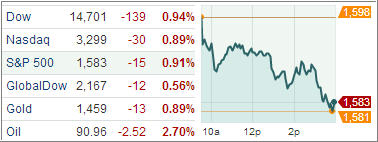Disappointing economic data finally dragged stocks down. The Dow Jones Industrial Average was down 138 points (0.9%) to 14,701, the S&P 500 Index lost 15 points (0.9%) from its record high to 1,583, and the Nasdaq Composite decreased 30 points (0.9%) to 3,299. Volume came in slightly lower than Tuesday. Commodity companies dropped the most among 10 S&P 500 industries as oil and copper tumbled.
The latest economic data continued a trend of indicators pointing to anemic growth. The ISM Manufacturing Index fell 0.6 points in April to 50.7. It was the lowest level this year, as factory activity expanded for the fifth straight month, but at a slower pace as the manufacturing recovery has lost some momentum.
The decline was led by a sharp 4.0-point drop in the employment index, the most since September 2010. The inventory index fell 3.0 points as businesses ran down stocks for the second month in a row. Inventories continue to decline on a 12-month average basis, indicating a negative trend. Construction spending fell 1.7% in March, likely driven by funding cutbacks due to the sequester. The weakness was widespread. Public spending tumbled 4.1%, the most in 11 years, to its lowest level since October 2006. Residential spending slowed sharply to 0.4%. Private nonresidential fell 1.5%.
Investors’ sentiment was dampened by an ugly jobs picture. According to ADP, private nonfarm payrolls increased 119,000 in April, the fewest in seven months. The report noted slower job growth was due to “significant fiscal headwinds” from tax increases and government spending cuts. The service sector added 113,000 jobs. Manufacturing lost 10,000 positions. The report comes two days before the government releases its nonfarm payrolls growth count for April. Economists recently have been nudging down their projections after March’s dismal result. The weakness from the ADP report could cause expectations to dim even further.
U.S. manufacturing lost 10,000 positions according to ADP; but that was quickly overshadowed by a disappointing manufacturing report out of China showing output growth slowed more than expected. New export orders fell, raising more doubts about the world’s second-largest economy after a disappointing first quarter.
Elsewhere, the conclusion of the Federal Reserve’s two-day meeting revealed no changes. The Fed said it will keep buying bonds at a monthly pace of $85 billion while standing ready to raise or lower purchases as economic conditions evolve. In the near term, this action is positive for stocks although Wall Street had expected some kind of a boost as more stimulus may be needed to keep the indexes moving higher.
With earnings season two-thirds completed, according to S&P Capital IQ, first-quarter earnings for the S&P 500 currently stand at $26.44, the highest ever for a single quarter. How can that be possible, when it appears so many companies had such poor top-line growth? Your guess is as good as mine…
Our Trend Tracking Indexes (TTIs) pulled back but remain on the bullish side of their respective trend lines, with the Domestic TTI hovering at +3.75% while the International TTI retreated to +7.86%.
Contact Ulli
